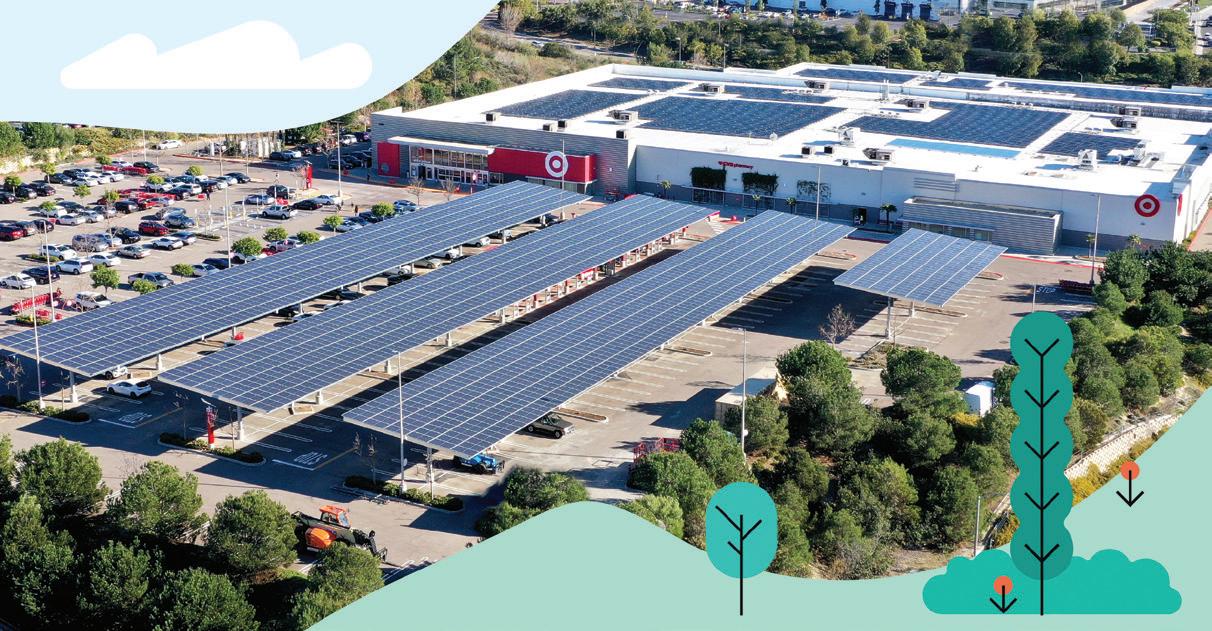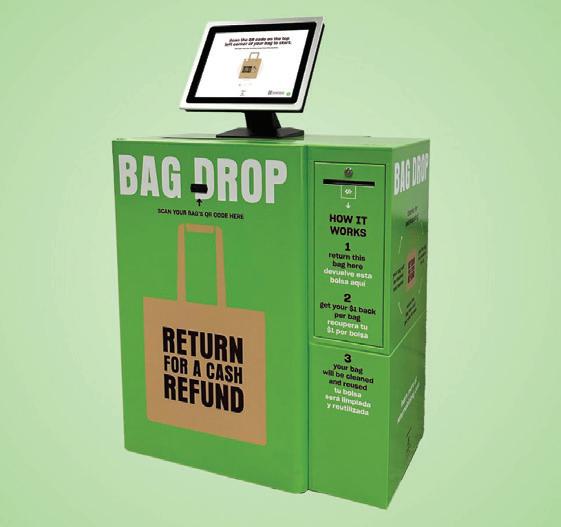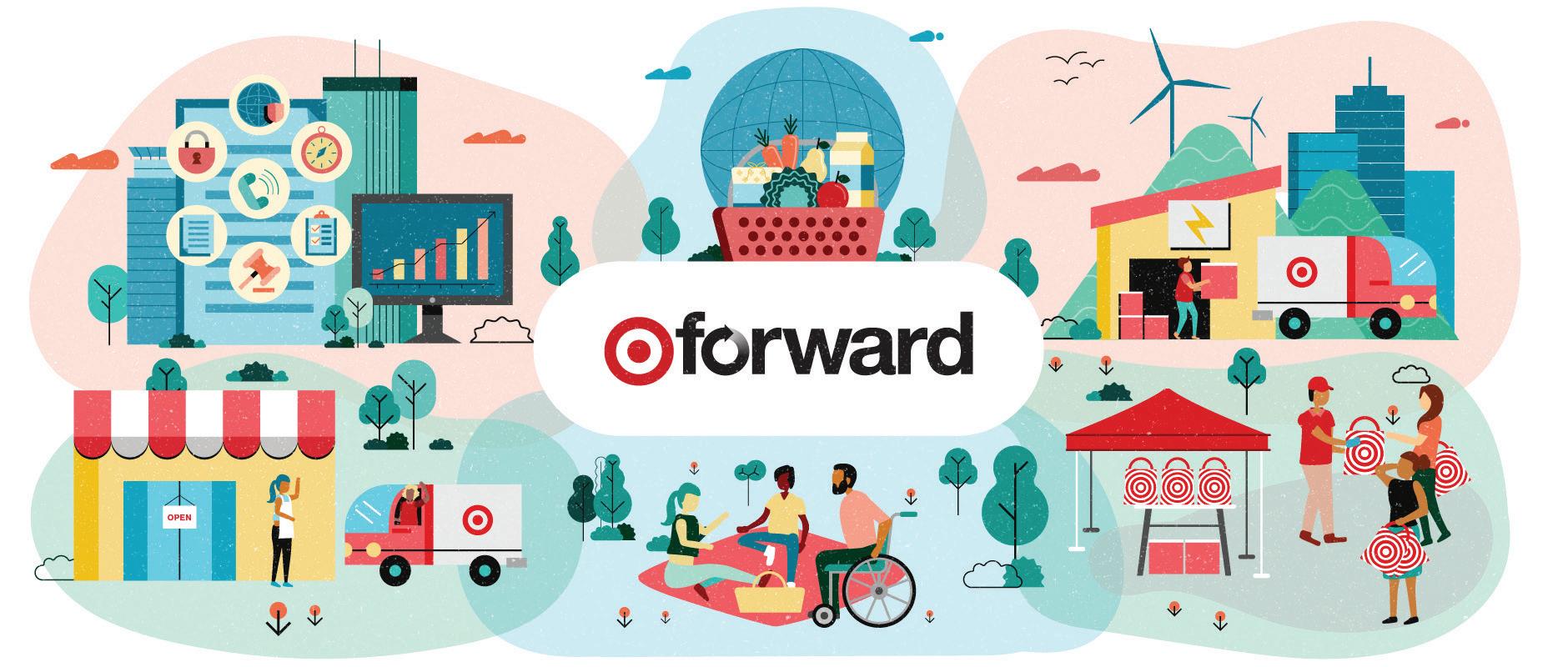
5 minute read
ON AISLE THREE GREEN UP
It was just under three years ago now that Target took up its role as a founding partner of the Consortium to Reinvent the Retail Bag, a campaign that set into motion a new era for retail across the US landscape and a milestone in its journey of sustainable development. We don’t just mean the (admittedly, very cool) development of carrier bags made from seaweed or pioneering new concepts in reuse that the project gave light to, but a far more significant movement that was taking place behind the scenes. The Consortium had, for the first time, brought together the world’s biggest retail giants – Walmart, Walgreens, Kroger, and CVS Health included – to work under the common goal of accelerating the transition to a more circular business model.
By this point, Target – a goliath of retail with close to 2,000 stores across the US and a total revenue of $109 billion as of 2022 – was well-andtruly on its pathway to reducing its footprint on the planet, but so too was everyone else.

Just as we have seen leading retailers unite to join the Refill Coalition here in the UK to pioneer a solution to end-to-end refill packaging for shoppers, so too do the leading retail brands of the North American market – if not the worldrecognise that real results can only be achieved through partnerships.
And while the focus of the Consortium may be on plastic bags – and let’s not for a moment underestimate the mountain that needs summiting here, with an estimated 100 billion plastic bags used annually in the US alone and only 10% of those being recycled – the sentiment reaches far beyond it.

In the same year it joined the Consortium, Target launched its revamped ESG strategy, Target Forward, an overarching game-plan to help the retailer reduce its environmental impact that crucially called on engagement and buy-in from across the stakeholder ecosystem.

“One year after the launch of Target Forward, I’m proud that dozens of initiatives are already underway to drive progress toward our goals, fuelled by our team and, critically, participation from our vendors, suppliers, and community partners,” says Amanda Nusz, senior vice president, Target corporate responsibility and president of the Target Foundation.
A bulk of that participation can be seen on shelf, through the 2022 launch of Target Zero – a specially curated collection of new and existing products within the Target portfolio designed to reduce waste and make it easier for consumers to shop sustainably.
Here you’ll find partners like Burt’s Bees, PLUS, and Pacifica as well as a host of hundreds of brands and products in stores across the US that have gone the distance in the pursuit of zero waste.
“It’s incredibly complex to get to zero waste,” says Erica Shea, Target senior buyer and sustainability lead for beauty. “Our goal with Target Zero is to not only make it easier for guests to find reduced-waste products that fit into their lifestyles, but also to co-create alongside our national brand partners and owned brands suppliers so we can unlock solutions to some of the historical hurdles for sustainability in the beauty, personal care, and household essentials spaces and beyond.”
You need not look too far to find such sentiments echoed by market ‘rival’ Walmart which, at the Licensing International Webinar: Sustainability Spotlight earlier this year sent in the big guns in the shape of Marco Reyes, senior director of sustainability to share with attendees the retailer’s work and strategy to become a regenerative company by 2040.
This itself is an over-arching mission statement that, during the presentation, Marco broke down into the four core pillars across which Walmart is operating towards that goal.

Walmart’s Nature strategy includes goals to reduce greenhouse gas emissions, protect and replenish biodiversity, and protect, restore, and sustainably manage nature. Under Waste you’ll find ambitions to achieve zero waste in its operations by 2025 across Canada, Japan, the UK, and the US; while under People, Walmart outlines its commitment to provide products that are both sustainable and safe for their customers.
But it’s under Climate we’ll find an ambition perhaps most motivating of all. Project Gigaton is Walmart’s mission to reduce or avoid one billion metric tonnes of greenhouse gases from its global value chain by 2030 and, with over 4,500 suppliers already formally signed on since its launch in 2017, it is one of the largest private sector consortiums for climate action in the world.
This is Walmart’s call to action to its community of stakeholders, but one that – as Marco told attendees of the Sustainability Spotlight in April – is fast shaping the kind of partners the retailer is looking towards.
It is the strive towards and alignment with the Walmart ESG strategy that will ultimately leverage the greatest shelf space it commands.
But make no mistake, Walmart wants the industry to move with it and is ready to provide suppliers the tools and information they need to join it on its journey of sustainable development – whether it’s the Sustainable Packaging Guideline, the Walmart Recycling Playbook, or the Sustainability Insights & Measurement Platform, Walmart has made it all readily available to partners at its Sustainability Hub.
And it would appear the tactic working. In spring last year, president and chief executive officer, Doug McMillon announced the team had hit the halfway milestone with Project Gigaton. Now, with less than seven years until 2030, and in light of the recent alarm bells sounded by the World Meteorological Organisation this month indicating the inevitability we will exceed the 1.5ºC threshold in one of the next five years, you can bet Walmart won’t be the only one to ratchet up the urgency and immediacy of its activities.
Because this is, as Target’s senior buyer and sustainability lead for beauty, Erica, reminds us, “just the beginning.”
“We all have a role to play when it comes to making more sustainable choices, and at Target, we’re committed to not only making improvements within our business but pushing the industry as a whole to do better by our planet,” she says.

At the launch of its Sports for Nature handbook last year, the United Nations Environment Programme reminded us that sport is ‘both deeply dependent on and connected to nature – that without a healthy planet, there is no playing field for sport.’
We’ve already seen this ring true when – at the start of this year - Switzerland admitted it would be hosting the Alpine Skiing World Cup on 100% artificial snow thanks to the warmer temperatures over winter.
Meanwhile, the catastrophic floods that hit Italy last month led to the cancellation of the Formula One Romagna Grand Prix, highlighting the direct impact severe weather from climate change will go on to have upon industry and society across the European continent.
Sport has an incredibly strong motivation to act. It also has a platform unlike anything else. Take football (soccer to our US readers) for instance. Estimated to be played by 265 million participants in 5,735 football stadiums worldwide, football reaches a global fanbase thought to be around five billion.
Which is why you’ll find Premier League teams like Tottenham Hotspur, Liverpool









